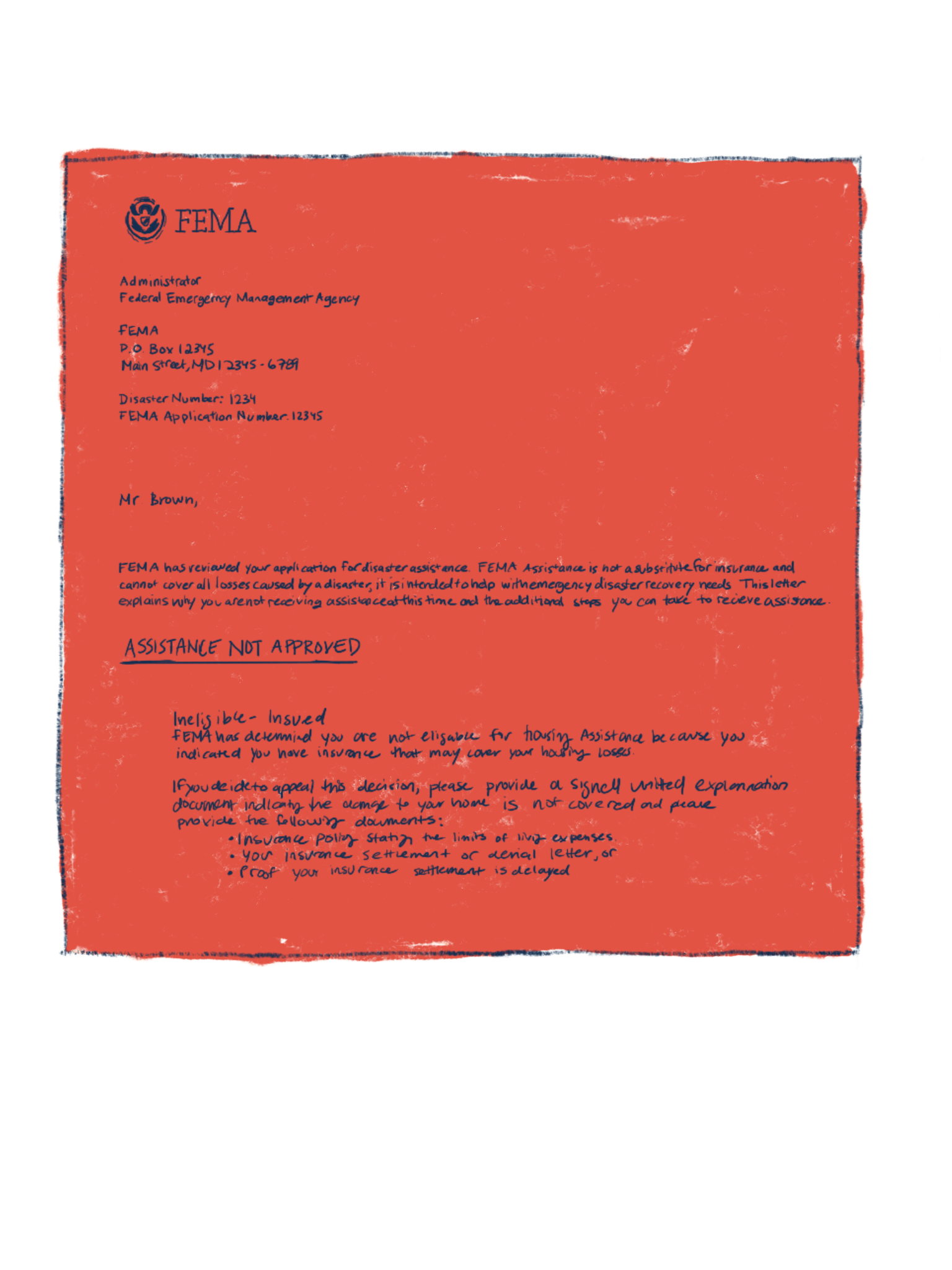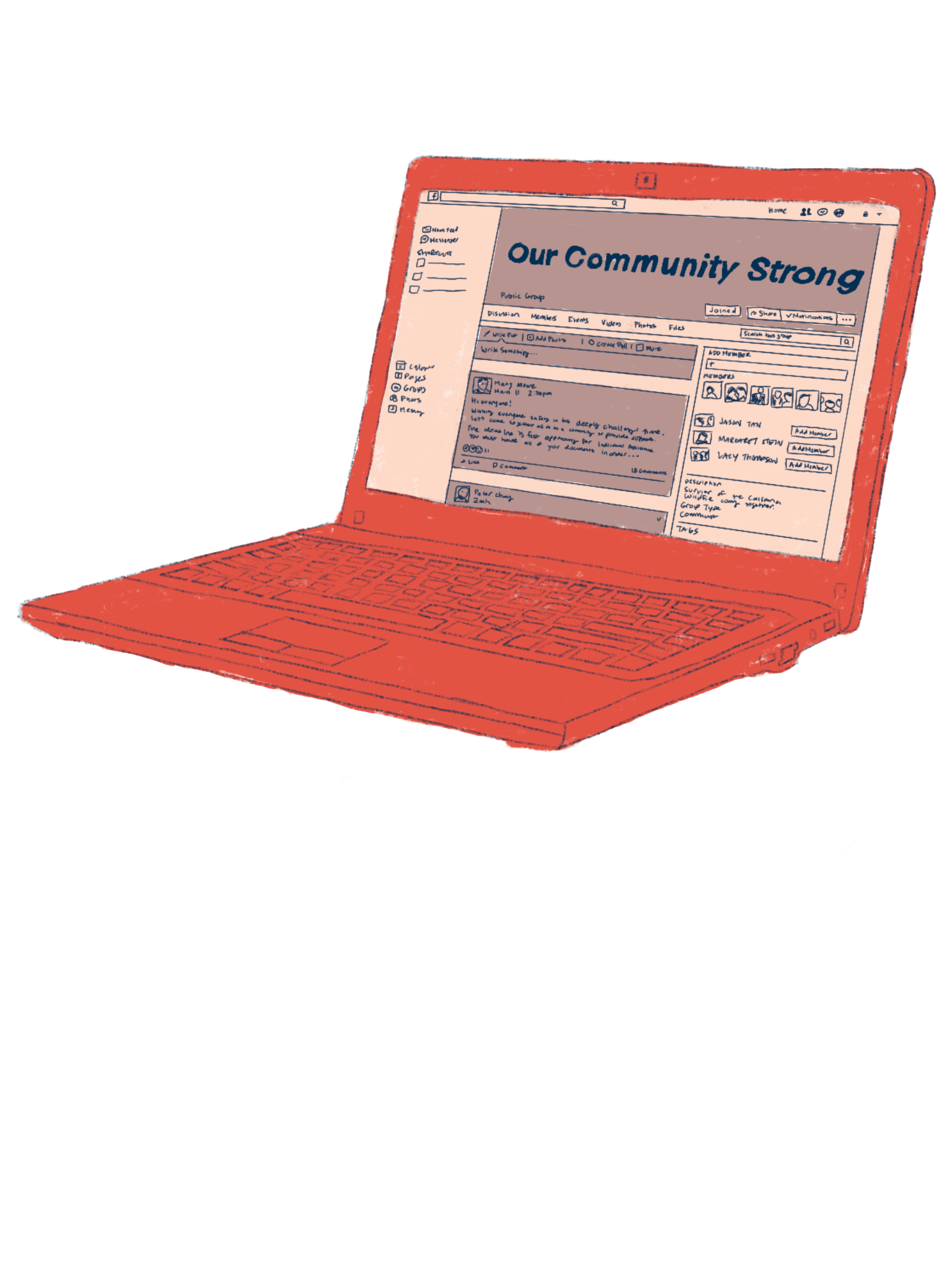I was really frustrated with all the paperwork and having to prove I needed help.
I told the case worker, 'I’ve already lost everything; haven’t I shown you enough to show you I’m deserving? Do you not trust what I’m saying?'
After receiving funds from FEMA, a son and daughter start work to rebuild their father’s home damaged by Hurricane Maria. They are starting the process by salvaging what they can until contractors, who are in high demand, can begin building a stronger concrete home.
FEMA/K.C. Wilsey
Where we are
An increasing number of Americans face natural disasters each year, yet they often lack the support necessary to fully recover.
When a natural disaster hits, survivors face the painful task of putting the pieces of their lives back together. They must care for basic needs and keep businesses going while enduring stress and trauma. On top of this, people must manage multiple bureaucratic processes with competing guidance, a confusing and frustrating journey at a moment when people expect government to show up and help.

1 Source: FEMA

Our approach
To start, we listened to people’s stories.
The Life Experience research team spoke with people nationwide about this moment in their lives and where the government process could have been simpler and more helpful. The listening sessions captured honest conversations about peoples' experiences, candid feedback on what could have worked better, and what really made a difference for them. Their stories have been combined and are represented here through illustrations. The quotes are real, but names have been changed.











The team conducted interviews in-person, virtually, in English, and in Spanish. Participants included people from twelve states and territories who have experienced hurricanes, tornadoes, and wildfires and represented various backgrounds—including low-income renters and home owners, parents, the elderly, new immigrants, veterans, and people with disabilities.
The team spoke with:
- 43 survivors
- 22 frontline staff
- 16 government / nonprofit staff
Discovery insights
Framing for collective thinking about customer pain points
How might we support survivors by minimizing the burden of navigating multiple applications?
How might we better design our information, interactions, and services for people who have endured a traumatic experience and may have ongoing stress?
How might we improve and coordinate our communications about the full range of Federal programs for the general public and small business owners alike?
Design Phase
Designing customer-centered solutions
View progress on our milestonesIn the 2024 design phase, the portfolio is running three pilot projects:
- Building a trauma-informed care approach will continue working with agency representatives to refine and deliver pilot training modules for Federal staff who serve disaster survivors directly to develop their awareness of trauma-informed care principles to utilize while working on location with people seeking Federal services or assistance.
- Calculating a more holistic burden estimate will work with Federal agency High Impact Service Providers (HISPs) to pilot the method and tool, and aims to continue burden assessments within disaster recovery.
- Streamlining disaster assistance processes includes multiple
workstreams, including updates to Disasterassistance.gov, cross-agency referrals and data sharing, and registration process for disaster assistance.
The project aims to develop and test standardized design guidelines for communications, training, and consultation materials to improve the government’s response and interaction with the public. The interactions include in-person and print, letters, emails, and websites.
The design work will include creating guidelines and resource materials through iterative development and testing with Federal agency staff. These guidelines include training materials to promote better trauma-informed communications and interactions between agencies and disaster survivors.
Project objectives
Help agency and front-line staff have the knowledge, skills, and support via workshops, consultations, and resources to use a trauma-informed approach that enables a more sensitive and effective responsive recovery experience for disaster survivors.
The improvements will help increase survivor comprehension of critical information they receive in times of crisis and their ability to engage with resources and programs available to support them.
Updates
The team remained focused on developing trauma-informed approach tools for Federal staff serving disaster survivors in their communities after natural disasters. The team co-created a workshop program, an implementation guidebook, a course guidebook, and three videos for Federal staff. The team piloted the resources with over 350 disaster recovery staff from more than four Federal agencies. Careful attention was given to the training materials and the learning environment to ensure a meaningful experience, and feedback from staff overwhelmingly favored in-person training over virtual delivery. Post-training surveys revealed that over 90% of participants reported a significant shift in their understanding of the communities they serve after attending the workshop. The workshop’s three modules covered: (1) Recognizing different forms of trauma and understanding how staff may experience trauma themselves; (2) Learning practical skills for improving interactions with survivors, such as listening without judgment, building trust, and creating a sense of safety; and (3) Learning tools for self-care, stress management, and seeking support.
In addition, the team continued research on the survivor experience at Disaster Recovery Centers (DRCs) with the goal to identify opportunities and approaches to enhance on-the-ground support and integrate trauma-informed approaches. In addition, the team partnered with the Office of Evaluation Sciences (OES) in the General Services Administration to conduct a descriptive study to examine disaster survivor visits to DRCs.
See the 2024 project evaluation plan to learn about the project measures and methods.
Early in project development, the team learned that disaster recovery staff across agencies are committed to improving their skills in working with survivors. The team co-created three training modules focused on the basics of trauma-informed care; working with survivors; and taking care of oneself when recovering from a disaster. The team piloted in-person training modules in FEMA Region 2, created prototypes of three videos, and produced an accompanying guidebook.
In a site visit to a Disaster Recovery Center (DRC) in Vermont, the team learned first-hand from survivors about their challenges in obtaining Federal assistance. Survivors communicated that engaging with DRC staff helps overcome obstacles in the process. The team discovered that DRC staff are not trained in trauma-informed care or working with survivors, however. Federal staff also struggle to cope with the primary and secondary traumatic stress that may result from doing this work. The team believes that improvements in agencies’ work with disaster survivors will require agencies and front-line staff to integrate trauma-informed care principles and skills into their practices.
Measures of success
Key outcomes:
The trauma-informed care project will result in increased survivor comprehension and level of engagement with assistance programs.
Design phase project measures:
The project aims to calculate an end-to-end view and more informed estimate of the effort and cost required of disaster survivors and small business owners to apply for, maintain, and receive Federal disaster assistance benefits.
This “holistic burden assessment process” will be designed by building a burden assessment methodology, validating it with agency practitioners and academic experts, and testing it for usage and improvement with other service providers.
Project objectives
Create a consistent and replicable method for measuring and assessing end-to-end burden using a more uniform methodology to capture psychological, learning, and time costs.
High Impact Service Providers (HISPs), Life Experience teams, Federal agencies, and other delivery partners can use the toolkit for their burden assessments and better pinpoint opportunities to improve the customer experience and measure improvements and cost savings.
Updates
Many disaster survivors experience administrative burdens when they apply for Federal assistance. Applying for benefits and requesting services from multiple agencies and aid organizations can be repetitive, tiresome, and re-traumatizing, diverting time and attention from critical recovery tasks. Building on the initial phase of the Holistic Burden Assessment initiative, the team co-developed a toolkit to help agencies assess and measure administrative burdens. This toolkit was piloted with six Federal agencies, leading to several refinements to enhance its usability and functionality, producing a beta version of the toolkit.
See the 2024 project evaluation plan to learn about the project measures and methods.
“Administrative burden” refers to the costs of interacting with the government, such as time, money, and psychological stress. Typically, agency burden estimates are limited to the time it takes to complete a form, which doesn’t capture all of the effort and resources an individual might expend to navigate a government service.
The team developed a Holistic Burden Assessment process and prototype tool that uses a customer-centric perspective to learn, categorize, and measure burden across the entire customer journey, including aspects of psychological, learning, compliance, and redemption costs. The team reviewed existing models used worldwide and adapted these practices for use by Federal agencies. The team has initially tested the process and a calculator prototype to assess experiences of disaster survivors and small businesses; however, the calculations are incomplete until the team has more data and time to work with agency experts in the field.
Measures of success
Key outcomes:
Federal agencies and delivery partners involved in disaster recovery utilize the burden baseline toolkit for service improvements. HISPs, other Life Experience teams, or Federal agencies use the toolkit to understand customer experience burden baselines.
Design phase project measures:
The project aims to simplify the experience of applying for Federal disaster assistance programs, in response to extensive feedback from survivors that navigating across application forms can be confusing, frustrating, and often requires sharing the same information multiple times.
The design work involves analyzing data from the Federal Emergency Management Agency (FEMA) Individual Assistance (IA) registration and the Small Business Administration (SBA) disaster loan program, identifying critical moments for the most useful interagency collaboration and data sharing, conducting qualitative research on how to improve the registration process, and implementing changes to improve the application processes and forms themselves.
Project objectives
Improve how survivors begin FEMA’s Individual Assistance (IA) registration process, and clarify how FEMA IA and SBA’s disaster loan application offer direct assistance programs.
These improvements will reduce customer navigation burden, minimize duplication, and effectively communicate steps to access relevant assistance provided by multiple Federal entities. Ultimately, this will enable survivors to receive the aid they are eligible for more, quickly and expedite their recovery.
Updates
The Streamlining Disaster Assistance project contributed to reducing burden for disaster survivors applying for Federal aid. In partnership with FEMA, the team addressed critical issues with the mobile interface, improved the experience of survivor submissions, removed obsolete pages from DisasterAssistance.gov, and improved navigation and usability. Working with FEMA’s Recovery Technology Programs Division, the team updated the Registration Intake Form, simplifying the experience for users to complete it. Additionally, the team initiated the implementation of a new data-sharing capability that enables survivors to seamlessly share their information between FEMA and SBA platforms, simplifying applications for disaster assistance and loans.
Beyond survivor-focused outcomes, the team removed barriers to efficient software development. This included ensuring the development team had access to mobile devices for testing software updates and the necessary developer tools. In partnership with FEMA’s Digital Customer Service team, the project incorporated usability testing and field research to adopt a user-centric, data-driven approach to product development. These internal process improvements are expected to accelerate future streamlining efforts.
See the 2024 project evaluation plan to learn about the project measures and methods.
In early 2023, the team started the design phase with extended scoping to better understand the identified customer pain points in the intake and referral process (when the customer moves between FEMA and SBA). For example, the team learned from Disaster Recovery Center (DRC) staff that technology and communication barriers make it difficult for survivors to navigate the disaster registration intake process with FEMA and the referral process to other Federal agencies that provide individual assistance. The team worked with FEMA and SBA to gather and analyze customer navigation data. They focused on the referral process from FEMA to SBA and learned that 7 percent of all FEMA registrants ultimately apply for assistance with SBA. Evidence from in-person research suggests that survivors who could benefit from assistance from SBA do not understand that the agency provides assistance to homeowners.
The project team consulted with FEMA on potential improvements to disasterassistance.gov and SBA on enhancements to the MySBA Loan Portal to identify areas for improved coordination. Both agencies are progressing on internal changes that will improve the survivor experience and will further shape this project. The team also discussed the possibilities for data sharing and other developments with agency leaders during recurring Steering Committee meetings.
Measures of success
Key outcomes:
The project’s success is defined by its ability to reduce customer navigation burden, minimize duplication, and effectively communicate steps to access relevant assistance provided by multiple Federal entities, which will enable more survivors to receive the aid they are eligible for and recover more quickly.
Project Documentation
- Portfolio Charter
- Portfolio One-Sheet
- Design Project Summary: Building a Trauma Informed Care Approach
- Design Project Summary: Calculating a More Holistic Burden Estimate
- Design Project Summary: Streamlining Disaster Assistance Processes
- Customer Journey Map & Stories
- Information collection approved under OMB Control #3206-0276
- Life Experience Initiative Summary
- Executive Order 14058
- President’s Management Agenda
Project Outputs
- Trauma-Informed Disaster Response Course
- Calculating a More Holistic Burden
- Evaluation Plan: Streamlining Disaster Assistance Processes
- Evaluation Plan: Building a Trauma Informed Care Approach
- Evaluation Plan: Calculating a More Holistic Burden Estimate
Agency collaborators
- General Services Administration (GSA)
- Department of Housing and Urban Development (HUD)
- Department of Agriculture (USDA)
- Office of Management and Budget (OMB)
- Department of Health & Human Services (HHS)
- Small Business Administration (SBA)
- Department of the Interior (DOI)
- Department of Commerce (DOC)
- Department of Homeland Security (DHS)
